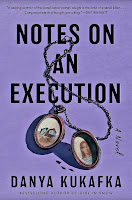Book Review:Notes on an Execution by Danya Kukafka
 |
Meet forty-six-year-old Ansel Packer, Inmate # 999631 in a Texas Prison, twelve hours away from execution for the murder of three teenage girls twenty-nine years ago. Dubbed 'The Girly Killer', he fancies himself a philosopher and is hopeful that his story and 'Theory', which he has documented in a stack of notebooks, will be published and revels in thinking of the fanfare that would follow.
Through multiple POVs and different timelines, the narrative follows Ansel’s life from his birth and early years on a farm till the moment he takes his final breath. We follow Ansel Packer in the present as he counts the hours leading to his execution. The larger part of the narrative describing Ansel’s past, his crimes, victims, and eventual capture is told through the POVs of three women. This is an exploration of his past and the impact his life and actions have had on the women in his periphery. We meet Ansel’s mother, Lavender, a teenager herself when he was born, who abandoned her two children to escape a stifling abusive relationship only to resurface years later at a commune in California. She never meets her son again, though she does get to know of his deeds and the fate that awaits him. She ponders her role in what Ansel has become and knows that the first four years of his life haunt both her and her son for the rest of their days.
“Lavender knew, then, that the world was a forgiving place. That every horror she had lived or caused could be balanced with such gutting kindness. It would be a tragedy, she thought—inhumane—if we were defined only by the things we left behind.”
The second person we hear from is Saffron (Saffy) Singh, who was once housed in the same group home in the foster care system as was Ansel and who had witnessed Ansel’s evil streak and his vindictiveness as a child. We meet her again as an adult climbing the ladder of law enforcement, progressing from Investigator to eventually Captain with the New York State Police. Her interest in the serial killer becomes personal when one of the victims turns out to be a childhood friend who was once housed with her and Ansel.
“Some men, Saffy knew, killed from a place of anger. Others killed from humiliation, or hatred, or depraved sexual need. Ansel was not rare or mystifying. He was the least nuanced of them all, a murky combination of all the above. A small and boring man who killed because he felt like it.”
The third POV is that of Hazel, his former sister-in-law who though once impressed by his charm, was not quite sure what to make of him but has long since seen his darker side and was instrumental in helping her sister Jenny to leave him and start afresh.
“There are millions of men out there who want to hurt women—people seem to think that Ansel Packer is extraordinary, because he actually did.”
“Ansel gets the glorified title of serial killer, a phrase that seems to inspire a bizarre, primitive lust. Books and documentaries and dark tunnels on the internet. Crowds of women captivated.”
The author is sharp in her criticism of the fascination that the general public, print and entertainment media express with serial killers . She places emphasis on the effect of his actions on the people he leaves behind and the aftermath of the crimes on the families- the victims’ and his own. The author gives a voice to the people who have played a role in Ansel's life - the same people whose lives have been irrevocably altered by their association with him and will be left dealing with their own feelings of hurt, grief and trauma long after Ansel is gone.
“Twenty years have passed since they found the bodies—twenty-nine since the girls went missing—and still, a news camera hovers at the edge of the vigil, determined to make a story. Saffy feels slimy, the truth prickling. There would be no story, for these girls alone. There would be no vigil, no attention at all. They are relevant because of Ansel and the fascination the world has for men like him.”
Dark, compelling and thought-provoking, with an interesting cast of characters, Danya Kukafka’s Notes on an Execution is an engaging, if not easy, read. The scenes depicting animal cruelty were difficult to take in. While I understand the need for Lavender's contributon to the narrative, I felt that Blue should have been given her own POV as she does play a significant role in the latter part of Ansel’s story. Having said that, it should be noted that this novel does not follow a standard serial killer thriller structure wherein we follow an investigator searching for the identity of an unknown serial killer. At the very onset of this novel it is established that we know the killer, we know he did it, we know he has been caught and we know he is on death row awaiting execution. So, what’s left to know? The answer: A lot.
“Good and evil are simply stories that we tell ourselves, narratives we’ve created to justify being alive. No person is wholly good, and no person is wholly evil. Everyone deserves the chance to keep living, don’t you think?”
Comments
Post a Comment